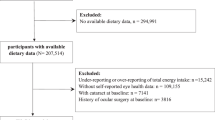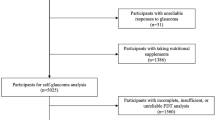Abstract
Background
In Western countries, many epidemiological studies have demonstrated that specific dietary nutrients are associated with the risk of developing age-related cataracts. These reports have suggested that dietary antioxidant vitamins, in particular vitamin C, can play a role in preventing the onset or progression of age-related visual impairment. However, few prospective studies have examined this relationship in a general Asian population. Therefore, in this study, we investigated whether dietary vitamin C was associated with a lower incidence of age-related cataracts by performing a 5-year prospective population-based analysis using data from a cohort of over 30,000 Japanese residents recruited to the Japan Public Health Center-based Prospective Study (JPHC Study) cohort I.
Aim of the study
We carried out a prospective analysis of the association between vitamin C intake and age-related cataracts among middle-aged Japanese, to study the effects of dietary antioxidants in an Asian population.
Methods
This 5-year population-based study included 16,415 men and 18,771 women (aged 45–64 years), who were recruited onto the JPHC Study and had not reported cataracts in baseline surveys. Vitamin C was calculated from the nutrient intake assessed by self-administered food-frequency questionnaires (FFQ). Self-reported questionnaires were used to assess two endpoints: diagnosis or extraction of cataracts.
Results
At follow-up, 216 men and 551 women reported new diagnoses, and 110 men and 187 women reported extractions of cataracts. For both endpoints, a higher vitamin C intake was associated with a reduced incidence of cataracts in both sexes. After adjusting for potential confounding factors, the multivariate odds ratios (ORs) for men and women in the highest quintiles of energy-adjusted vitamin C intake, relative to the lowest quintiles, were 0.65 (95% CI, 0.42–0.97) and 0.59 (95% CI, 0.43–0.89) for cataract diagnoses, and 0.70 (95% CI, 0.44–1.20) and 0.64 (95% CI, 0.41–0.94) for cataract extractions, respectively.
Conclusions
Dietary vitamin C intake might lower the risk of age-related cataracts among middle-aged Japanese.
Similar content being viewed by others
References
Lesk MC, Sperduto RD (1983) The epidemiology of senile cataracts: a review. Am J Epidemiol 118:152–165
Jacques PF, Taylor A (1991) Micronutrients and age-related cataracts. Micronutrients in health and in disease prevention. Marcel Dekker, New York, pp 359–379
Taylor A (1999) Nutritional and environmental influences on risk for cataract. Nutritional and Environmental Influences on Vision. CRC Press, Boca Raton, FL, pp 53–93
Jacques PF (1993) Antioxidant and cataracts. Epidemiology 4:191–193
Varma SD, Srivastava VK, Richards RD (1982) Photoperoxidation in lens and cataract formation: preventive role of superoxide dismutase, catalase and vitamin C. Ophthalmic Res 14:167–175
Varma SD (1991) Scientific basis for medical therapy of cataracts by antioxidants. Am J Clin Nutr 53(Suppl):335S–345S
Jacques PF, Chylack LT Jr (1991) Epidemiologic evidence of a role for the antioxidant vitamins and carotenoids in cataract prevention. Am J Clin Nutr 53(Suppl):352S–355S
Leske MC, Chylack LT Jr, Wu SY (1991) The lens opacities case-control study. Risk factors for cataract. Arch Ophthalmol 109:244–251
Mares-Perlman JA, Brady WE, Klein BE, Klein R, Haus GJ, Palta M, et al. (1995) Diet and nuclear lens opacities. Am J Epidemiol 141:322–334
Lyle BJ, Mares-Perlman JA, Klein BE, Klein BE, Klein R, Greger JL (1999) Antioxidant intake and risk of incident age-related nuclear cataracts in the Beaver Dam Eye Study. Am J Epidemiol 149:801–809
Cumming RG, Mitchell P, Smith W (2000) Diet and cataract: the Blue Mountains Eye Study. Ophthalmology 107:450–456
Jacques PF, Chylack LT Jr, Hankinson SE, Khu PM, Rogers G, Friend J, et al. (2001) Long term nutrient intake and early age-related nuclear lens opacities. Arch Ophthalmol 119:1009–1019
Taylor A, Jacques PF, Chylack Lt Jr, Hankinson SE, Khu PM, Rogers G, et al. (2002) Long-term intake of vitamins and carotenoids and odds of early age-related cortical and posterior subcapsular lens opacities. Am J Clin Nutr 75:540–549
Valero MP, Fletcher AE, De Savola BL, Vioque J, Alepuz VC (2002). Vitamin C is associated with reduced risk of cataract in a Mediterranean population. J Nutr 132:1299–1306
Vitale S, West S, Hallfrisch J, Alston C, Wang F, Moorman C, et al. (1993) Plasma antioxidants and risk of cortical and nuclear cataract. Epidemiology 4:195–203
Tavani A, Negri E, La Vecchia C (1996) Food and nutrient intake and risk of cataract. Ann Epidemiol 6:41–46
Taylor A, Hobbs M (2001) 2001 assessment of nutritional influences on risk for cataract. Nutrition 17:845–857
Tsugane S, Gey F, Ishinowatari Y, Miyajima Y, Ishibashi T, Matsushima S, et al. (1992) Cross-sectional epidemiologic study for assessing cancer risk at the population level. I: study design and participation rate. J Epidemiol 2:75–81
Science and Technology Agency (1982) Standard Tables of Food Composition in Japan. The fourth revised edition. Tokyo, Printing Bureau, Ministry of Finances (in Japanese)
Kobayashi M, Sasaki S, Tsugane S (2003) Validity of self-administered food frequency questionnaire used in the 5-year follow-up study of the JPHC Study Cohort I to assess carotenoids and vitamin C intake: comparison with dietary records and blood level. J Epidemiol 13(Suppl):S82–S91
Takashima Y, Yoshida M, Yoshinaga A, Sasaki S, Tsugane S, for the JPHC Study Group (2002) Usefulness of the recall-based self-report as a means of case definition in epidemiological studies on senile cataracts. Jpn J Health Human Ecol 68:43–53
Willett W, Stampfer MJ (1986) Total energy intake: implications for epidemiologic analysis. Am J Epidemiol 124:17–27
SAS Institute Inc (1999) SAS/STAT User’s Guide, Version 8.2. SAS Institute Inc., Cary, NC
Robertson JMD, Donner AP, Trevithick JR (1989) Vitamin E intake and risk for cataracts in humans. Ann NY Acad Sci 570:372–382
Jacques PF, Taylor A, Hankinson SE, Willett WC, Mahnken B, Lee Y, et al. (1997) Long-term vitamin C supplement use and prevalence of age-related lens opacities. Am J Clin Nutr 66:911–916
Mares-Perlman JA, Lyle BJ, Klein R, Fisher AI, Brady WE, VandenLangenberg GM, et al. (2000) Vitamin supplement use and incident cataracts in a population-based study. Arch Ophthalmol 118:1556–1563
Hankinson SE, Stampfer MJ, Seddon LM, Colditz GA, Rosner B, Speizer FE, et al. (1992) Nutrient intake and cataract extraction in women: a prospective study. BMJ 305:335–339
Seddon JM, Christen WG, Manson JE, LaMotte FS, Glynn RJ, Buring JE, et al. (1994) The use of vitamin supplements and risk of cataract among US male physicians. Am J Public Health 84:788–792
Mares-Perlman JA, Klein BEK, Klein R, Ritter LL (1994) Relationship between lens opacities and vitamin and mineral supplement use. Ophthalmology 101: 315–325
The Italian-American Cataract Study Group (2005) Associations between plasma levels of vitamins and cataract in the Italian–American clinical trial of nutritional supplements and age-related cataract (CTNS): CTNS report #2. Ophthalmic Epidemiol 12:71–80
Sperduto RD, Hu TS, Milton RC, Zhao JL, Everett DF, Cheng QF, et al. (1993) The Linxian Cataract Studies: two nutrition intervention trials. Arch Ophthalmol 111:1246–1253
Age-Related Eye Disease Study Research Group (2001) A randomized, placebo-controlled, clinical trial of high-dose supplementation with vitamin C and E and beta carotene for age-related cataract and vision loss. Arch Ophthalmol 119:1439–1452
Gritz DC, Srinivasan M, Smith SD, Kim U, Lietman TM, Wilkins JH, et al. (2006) The Antioxidants in Prevention of Cataracts Study: effects of antioxidant supplements on cataract progression in South India. Br J Ophthalmol 90:847–851
Simon JA, Hudes ES (1999) Serum ascorbic acid and other correlates of self-reported cataract among older Americans. J Clin Epidemiol 52:1207–1211
Berger J, Shepard D, Morrow F, Taylor A (1989) Relationship between dietary intake and tissue levels of reduced and total vitamin C in the guinea pig. J Nutr 119:734
Blondin J, Baragi V, Schwartz E, Sadowski J, Taylor A (1986) Delay of UV-induced eye lens protein damage in guinea pig by dietary ascorbate. J Free Radic Biol Med 2:275
Knekt P, Heliovaara M, Rissanen A, et al. (1992) Serum antioxidant vitamins and risk of cataract. BMJ 305:1392–1394
Acknowledgments
This study was supported by Grants-in-Aid for Cancer Research and for the Third Term Comprehensive Ten-Year Strategy for Cancer Control from the Ministry of Health, Labor and Welfare of Japan. The authors thank all staff members in each study area for their efforts with baseline and follow-up surveys.
Author information
Authors and Affiliations
Consortia
Corresponding author
Additional information
Study Group Members: Members of the Japan Public Health Center-based Prospective Study Group are: S. Tsugane, M. Inoue, T. Sobue, T. Hanaoka, National Cancer Center, Tokyo; J. Ogata, S. Baba, T. Mannami, A. Okayama, National Cardiovascular Center, Suita; K. Miyakawa, F. Saito, A. Koizumi, Y. Sano, I. Hashimoto, Iwate Prefectural Ninohe Public Health Center, Ninohe; Y. Miyajima, N. Suzuki, S. Nagasawa, Y. Furusugi, Akita Prefectural Yokote Public Health Center, Yokote; H. Sanada, Y. Hatayama, F. Kobayashi, H. Uchino, Y. Shirai, T. Kondo, R. Sasaki, Y. Watanabe, Y. Miyagawa, Nagano Prefectural Saku Public Health Center, Saku; Y. Kishimoto, E. Takara, T. Fukuyama, M. Kinjo, M. Irei, H. Sakiyama, Okinawa Prefectural Chubu Public Health Center, Okinawa; K. Imoto, H. Yazawa, T. Seo, A. Seiko, F. Ito, F. Shoji, Katsushika Public Health Center, Tokyo; A. Murata, K. Minato, K. Motegi, T. Fujieda, Ibaraki Prefectural Mito Public Health Center, Mito; K. Matsui, T. Abe, M. Katagiri, M. Suzuki, Niigata Prefectural Kashiwazki and Nagaoka Public Health Center, Kashiwazaki and Nagaoka; M. Doi, A. Terao, Y. Ishikawa, Kochi Prefectural Chuo-higashi Public Health Center, Tosayamada; H. Sueta, H. Doi, M. Urata, N. Okamoto, F. Ide, Nagasaki Prefectural Kamigoto Public Health Center, Arikawa; H. Sakiyama, N. Onga, H. Takaesu, Okinawa Prefectural Miyako Public Health Center, Hirara; F. Horii, I. Asano, H. Yamaguchi, K. Aoki, S. Maruyama, M. Ichii, Osaka Prefectural Suita Public Health Center, Suita; S. Matsushima, S. Natsukawa, Saku General Hospital, Usuda; M. Akabane, Tokyo University of Agriculture, Tokyo; M. Konishi, K. Okada, Ehime University, Matsuyama; H. Iso, Y. Honda, Tsukuba University, Tsukuba; H. Sugimura, Hamamatsu University, Hamamatsu; Y. Tsubono, Tohoku University, Sendai; M. Kabuto, National Institute for Environmental Studies, Tsukuba; S. Tominaga, Aichi Cancer Center Research Institute, Nagoya; M. Iida, W. Ajiki, Osaka Medical Center for Cancer and Cardiovascular Disease, Osaka; S. Sato, Osaka Medical Center for Health Science and Promotion, Osaka; N. Yasuda, Kochi Medical School, Nankoku; S. Kono, Kyushu University, Fukuoka; K. Suzuki, Research Institute for Brain and Blood Vessels Akita, Akita; Y. Takashima, Kyorin University, Mitaka; E. Maruyama, Kobe University, Kobe; the late M. Yamaguchi, Y. Matsumura, S. Sasaki, S. Watanabe, National Institute of Health and Nutrition, Tokyo; and T. Kadowaki, Tokyo University, Tokyo.
Rights and permissions
About this article
Cite this article
Yoshida, M., Takashima, Y., Inoue, M. et al. Prospective study showing that dietary vitamin C reduced the risk of age-related cataracts in a middle-aged Japanese population. Eur J Nutr 46, 118–124 (2007). https://doi.org/10.1007/s00394-006-0641-8
Received:
Accepted:
Published:
Issue Date:
DOI: https://doi.org/10.1007/s00394-006-0641-8




